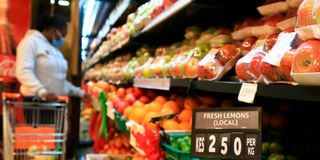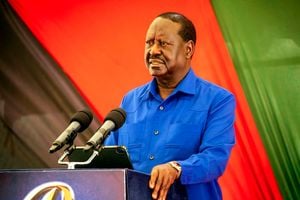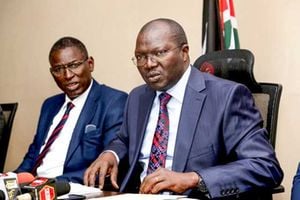Cost of Living: Fix food security, woo as many foreign investors as possible

A customer picks fruits at a Naivas supermarket in Nyeri. In Kenya, inflation is creeping upward. In September, as a monthly count, inflation came in at 9.2 per cent up from August’s 8.5 per cent.
Ronald Reagan famously said the “Government’s view of the economy could be summed up in a few short phrases. If it moves, tax it. If it keeps moving, regulate it. And if it stops moving, subsidise it.”
This sounds simple to do, however, many nations have taken swift actions and implemented policies during these uncertain times and, in some cases, to the detriment of the population.
A majority of us look at the government for the focus it gives to spending patterns. There is a tendency to focus on monetary policy, economic planning, and growth as these have a tripartite relationship, which influences specific segments of policies in countries such as Kenya.
The policies and economic administration have large ramifications on the cost of living, price rise or how prices need to be contained, and how inflation needs to be reined in.
This broadly falls under the rubric of economic administration. Monetary policy is concerned with decisions influencing the cost and availability of money in the economy, focusing on the availability of credit, and how much credit is to be issued and not just regulating the money supply alone.
The macroeconomic concepts broadly have a bearing on the financial administration, too. The government takes advice from different sectors. Key factors that assist in determining the course of action are guided by macroeconomic factors. These usually relate to the phenomenon of output, unemployment, and inflation.
Inflation continues to rise across global economies. As per the IMF data, “global inflation is forecast to rise to 8.8 per cent in 2022 from 4.7 per cent in 2021”. In Kenya, inflation is creeping upward. In September, as a monthly count, inflation came in at 9.2 per cent up from August’s 8.5 per cent.
September's figure represented the highest inflation rate since June 2017. The acceleration was broad-based, with greater price pressures recorded for food and non-alcoholic beverages, housing, utilities and fuel, and transportation.
The average inflation in Kenya for the year 2022 is anticipated at 7.7 per cent. At times such as these, perhaps lowering the price of fuel could ease the burden. Policymakers could also focus on avenues and attractive policies to encourage local and international investors to set up manufacturing plants across Kenya.
Value chain
This could lead to an increase in the value chain of production and output locally. Not only will these actions generate employment, but over time, the benefit from economies of scale could also boost competitive pricing and encourage exports.
One of the other major national accounting systems economists interested in the long-run development of the country study is the economic growth model.
According to Statistica, “Kenya's unemployment rate was 5.74 per cent in 2021. This represents a steady decline from the increase after the financial crisis”. The labour force includes workers actively looking for jobs. People who are retired, pursuing education, or discouraged from seeking work by a lack of job prospects are all excluded from the labour force.
The economic policy administration closely studies the pattern of employment growth. The focus needs to be shifted to the types of unemployment and the policy options available. Classical unemployment occurs when wages are too high for employers to hire more workers.
Frictional unemployment occurs when appropriate job vacancies exist for a worker. However, the length of time needed to search for and find a job leads to unemployment. Structural unemployment covers a variety of possible causes of unemployment, including a mismatch between workers' skills and skills required for the jobs.
The economic policy must consider these types of mismatches. That is the reason the hiatus between the general administration or education systems in Kenya and the required skill sets for the market are sought to be bridged through skills-based courses across the country.
The government is finding solutions through “Made in Kenya” initiatives via TVET or Technical and Vocational Education Training. Statistics show that “As of 2020, Kenya counted 451.2 thousand students enrolled in TVET, nearly three times more than in 2013”.
To address inflation, unemployment, cost of living, and ease of access to essential services, there are strategic measures being implemented by nations.
If we look at trade, Kenya's trade policy objectives include moving towards a more open trade regime, strengthening and increasing overseas market access for Kenyan products, and further integration into the world economy. In order to secure the future, we must focus on the present.
The rising cost of living is a major challenge for the Kenyan population. A contributing factor is an increase in energy prices and food prices. Perhaps food security should be the topmost priority.
Being flexible with foreign investors could increase investment in the securities exchange as well as in manufacturing. This would in turn strengthen employment and increase the circular flow of money in the economy while maintaining the stability of the shilling against the dollar.
Ritesh Barot is a business and financial analyst. [email protected]





